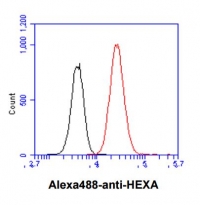ARG57022
anti-HEXA antibody [20F1]
anti-HEXA antibody [20F1] for Flow cytometry,Western blot and Human
Overview
| Product Description | Mouse Monoclonal antibody [20F1] recognizes HEXA |
|---|---|
| Tested Reactivity | Hu |
| Tested Application | FACS, WB |
| Host | Mouse |
| Clonality | Monoclonal |
| Clone | 20F1 |
| Isotype | IgG2a, lambda |
| Target Name | HEXA |
| Antigen Species | Human |
| Immunogen | Recombinant fragment around aa. 89-529 of Human HEXA. |
| Conjugation | Un-conjugated |
| Alternate Names | N-acetyl-beta-glucosaminidase subunit alpha; Beta-N-acetylhexosaminidase subunit alpha; EC 3.2.1.52; TSD; Beta-hexosaminidase subunit alpha; Hexosaminidase subunit A |
Application Instructions
| Application Suggestion |
|
||||||
|---|---|---|---|---|---|---|---|
| Application Note | * The dilutions indicate recommended starting dilutions and the optimal dilutions or concentrations should be determined by the scientist. |
Properties
| Form | Liquid |
|---|---|
| Purification | Purification with Protein A. |
| Buffer | PBS (pH 7.4), 0.02% Sodium azide and 10% Glycerol. |
| Preservative | 0.02% Sodium azide |
| Stabilizer | 10% Glycerol |
| Concentration | 1 mg/ml |
| Storage Instruction | For continuous use, store undiluted antibody at 2-8°C for up to a week. For long-term storage, aliquot and store at -20°C. Storage in frost free freezers is not recommended. Avoid repeated freeze/thaw cycles. Suggest spin the vial prior to opening. The antibody solution should be gently mixed before use. |
| Note | For laboratory research only, not for drug, diagnostic or other use. |
Bioinformation
| Database Links | |
|---|---|
| Gene Symbol | HEXA |
| Gene Full Name | hexosaminidase A (alpha polypeptide) |
| Background | This gene encodes the alpha subunit of the lysosomal enzyme beta-hexosaminidase that, together with the cofactor GM2 activator protein, catalyzes the degradation of the ganglioside GM2, and other molecules containing terminal N-acetyl hexosamines. Beta-hexosaminidase is composed of two subunits, alpha and beta, which are encoded by separate genes. Both beta-hexosaminidase alpha and beta subunits are members of family 20 of glycosyl hydrolases. Mutations in the alpha or beta subunit genes lead to an accumulation of GM2 ganglioside in neurons and neurodegenerative disorders termed the GM2 gangliosidoses. Alpha subunit gene mutations lead to Tay-Sachs disease (GM2-gangliosidosis type I). [provided by RefSeq, Jul 2009] |
| Function | Responsible for the degradation of GM2 gangliosides, and a variety of other molecules containing terminal N-acetyl hexosamines, in the brain and other tissues. The form B is active against certain oligosaccharides. The form S has no measurable activity. [UniProt] |
| Calculated MW | 61 kDa |
| PTM | N-linked glycan at Asn-115 consists of Man(3)-GlcNAc(2). |
Images (3) Click the Picture to Zoom In
-
ARG57022 anti-HEXA antibody [20F1] FACS image
Flow Cytometry: A549 cell line stained with ARG57022 anti-HEXA antibody [20F1] at 2-5 µg for 1x10^6 cells (red line). Secondary antibody: Goat anti-Mouse IgG Alexa fluor 488 conjugate. Isotype control antibody was Mouse IgG (black line).
-
ARG57022 anti-HEXA antibody [20F1] WB image
Western blot: 40 µg of MCF7 cell lysate stained with ARG57022 anti-HEXA antibody [20F1] at 1:3000.
-
ARG57022 anti-HEXA antibody [20F1] WB image
Western blot: 10 µg of 1) 293T cell lysate, 2) HEXA Transfected 293T cell lysate stained with ARG57022 anti-HEXA antibody [20F1] at 1:3000.








